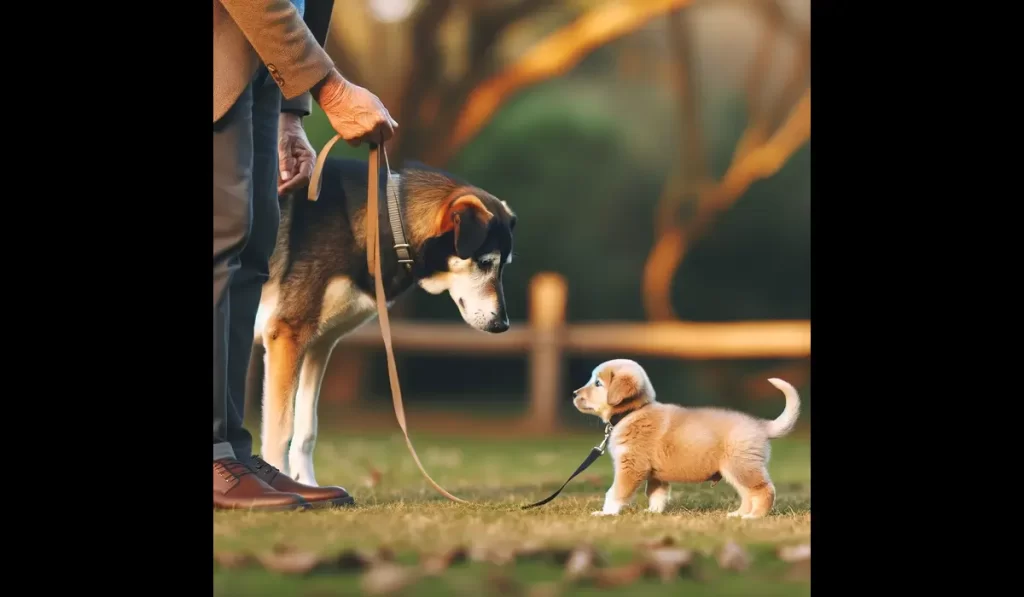Summary
Introducing a puppy to your older dog requires patience and a gradual approach. Before meeting, exchange scents. The first meeting should be in neutral territory, leashed and supervised, allowing them to sniff at their pace. Reward calm behavior and watch for signs of tension, separating them if needed. Keep initial meetings short. Provide separate spaces initially for eating and resting. Supervise playtime and address dominance through puppy obedience. Prevent resource guarding by feeding separately and removing toys when unsupervised. Continue one-on-one time with your older dog. Avoid forcing interactions or leaving them unsupervised with potential conflict items. Seek professional help for aggression or persistent tension.
How to Introduce a Puppy to an Older Dog?
You can’t teach new and different tricks to your older dog.
Still, you can teach them to welcome a new canine friend and let them know how to share by following some tips that could help you and your older dog get along with your new puppy
by not damaging or negatively impacting your older dog’s mental and physical health, as puppies have boundless energy.
Tips that must be taken into consideration are as follows.
Exchanging Scents
If you plan to buy a new puppy and take it to your home already, you can take a step forward to start the introduction.
Suppose you know what breed and which puppy you want to buy. In that case, you can ask the shelter manager to rub a piece of cloth on that puppy and put it near your older dog so that they can be familiar with that scent, which results in a better understanding of the older dog and the puppy.
‘Howdy Crate’
‘Howdy crate’ is a slang term used by zookeepers and people in shelters. ‘Howdy’ refers to ‘hello,’ and crate refers to a cage.
It is introducing your older dog to your puppy by placing the puppy in a cage or small cabin and placing that cabin on the front ground or anywhere the older dog can visit it. It can only say ‘hello’ to the puppy.
This is the safest way to introduce your older dog to your puppy.
Neutral Area
This is the best way to introduce the puppy to your older dog. Meetings should be done on open or neutral ground with fences where you can drop out leashes and let the dog and puppy get along with one another,
If a problem arises, you can easily hold the leashes and take the situation under your control.
This way, you need plenty of supervision and must take care of what happens there.
Move on to a Walk
A great way to make things move further, a walk is the best action you could take to make your puppy and the older dog comfortable with each other in natural settings.
Going for a walk can reduce anxiety and stress and enhance the capability of the dog and the puppy to fight and sense, which benefits them in becoming friendly with each other.
Ensure that your puppy is 16 weeks old and vaccinated, as it is harmful to take her outside in public places.
Training Games
When you consider taking things on, you need to engage your older dog and your puppy so that the presence of the two does not vex each other, and they can gain social skills. The most prominent way to make them engaging is the training games.
Training games are short sessions like grabbing a stick and asking your dog to fetch it, sitting and standing actions, high five, etc. Playing together increases their sniffing and comfort, which can show positive results.
The Amalgamation of Rivals
Taking out both in public areas other than parks and a friend’s house can lead the dog and the puppy to notice each other more and ensure a feeling of togetherness.
In this way, their attention will focus on the scent of other dogs, and suddenly, there will be an amalgamation of rivalries and allies.
Follow Your Dog’s Lead
Some dogs tend to get along with each other more frequently than others. There is nothing to worry about. You only need to make a proper space for them to move on and adapt to each other’s personalities.
Use a Leash
Keep both the dogs on a leash with someone calm at the end. Keep the leash relaxed so there will be no tension in the dog. Our dogs can easily sense anxiety, and it can interrupt their meeting.
Look for Positive Signs
It is a good and positive sign that the two of them want to pay together. The body language speaks the most. The dog’s body language will tell you about their feelings, and if they wish to proceed and form a friendship, let them do their part.
How to Introduce a Puppy to a Dominant Dog?
If your existing adult dog is not getting friendly and comfortable with other dogs, then it might be a problem for you to bring a puppy home. Several factors can help you in selecting the right fit for your family. These include the breed of the dog, the age, and the sex of the puppy.
It is important to note that there must not be any attention depletion to the other dog. There is nothing that a dog ‘hates.’ If the dogs are not friendly with one another, there is always a place to grow and change.
Adult dogs or senior dogs, just like us, want to raise puppies as we do want to raise kids if they have the energy to do so. It is not like the puppies are ‘obnoxious’ to them. It is just that they have another state of sense and understanding.
The best thing we can do for older dogs so that they can live pleasantly and peacefully with the puppies is to make the little puppy work out. Start the training and workout sessions for the puppy.
The parenting instincts will automatically kick in when the older dog sees the puppy learning things. It will take the puppy under its wings, protect and train it, and feel, ‘This is my puppy.’
Supervision must be constant so that you can control and direct if some problem comes into being.
How to Avoid Problems in Introducing a Puppy to an Older Dog?
Above all, there are great ways to acknowledge when introducing your puppy to your older dog. These ways can help the puppy and dog bond well with each other. But all these activities require proper supervision and involvement from you.
Here are some tips that you must follow to avoid problems between your puppy and senior dog.
Different Rooms
Your house can be a boxing ring for your two pets. Give each dog or puppy their separate corners when they are not supervised.
Toy-Free Area
Put all the toy products away from them, as this can create a common form of aggression.
Supervised Chewing
Suppose you wish to treat your dogs with food like chewing bones. In that case, it is an excellent thought, but put your dogs in the opposite corner of the room and remove the one who finishes chewing fast.
In conclusion, you need to take care of what to do and what not to do to give the best outcome in training your dogs.
Do’s and Don’ts While Introducing a Puppy to an Older Dog
It will help to keep a few things in mind while introducing your puppy to an older dog. The process might be intimidating but not challenging.
What to Do
Change is difficult for everyone, and when it comes to pets, it is essential to make our pets comfortable in their environment and surroundings. Some points must be contemplated while introducing a puppy to an old dog.
- Allow them to get used to each other at their tempo.
- Do allow them to play under supervision.
- Spend time separately with each of them so that they don’t have a sense of jealousy.
- Do supervise them accordingly for several weeks to avoid problems
- Do allow them to interact if they wish to do so.
- Do allow them to move out of their crate when desired.
- Do introduce them to a natural and neutral area.
What Not to Do
Being conscious and diligent towards the pet can show better and more positive results. You must take care of a few things and avoid circumstances that can adversely affect the pet.
- Do not let the older dog bully the puppy.
- Don’t ever allow both the dogs to fight each other in the sense of playing.
- Do not hold the puppy in your arms while doing the introduction process.
- Please don’t force them to get used to one another. This might create tension and anxiety among the dogs.
- Don’t place them in a standard crate. Buy a new crate to avoid unnecessary fighting and problems.
Following the above steps and ways can create a positive transition between your puppy and your dog. Also, they will feel more comfortable and pleasant with one another if you help them make friends and know each other well.
It will be a stressful situation sometimes, but it will produce positive and happy results. In return, you will be awarded many puppy kisses and cuddles.
If necessary, you should get help from a professional trainer, take interventions, and follow the steps to introduce a puppy to an older dog.
Hence, this was all about introducing a puppy to an older dog.


